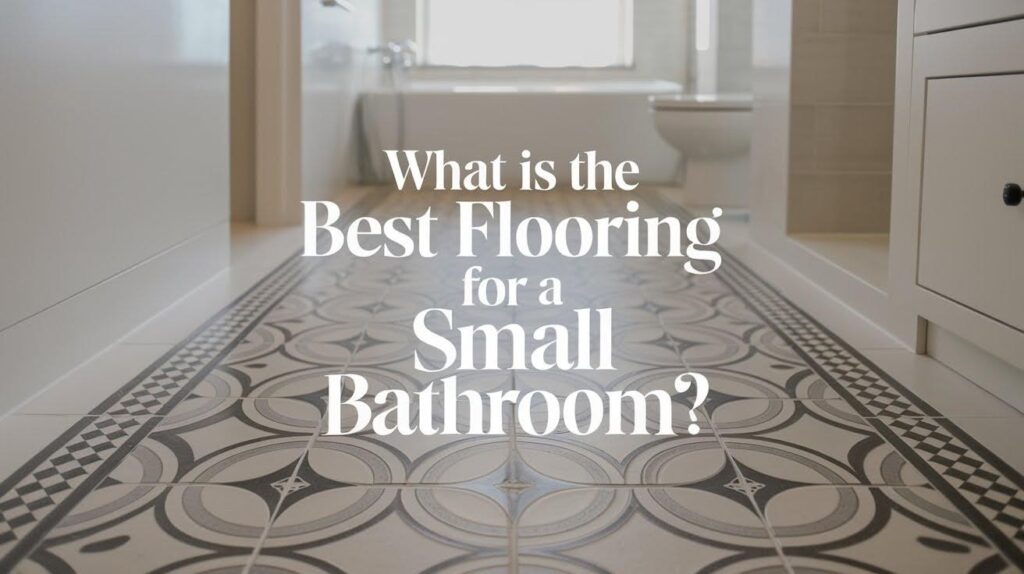Choosing flooring for your small bathroom feels overwhelming. I get it.
You want something that looks great, handles moisture, and won’t break your budget. After installing flooring in over 300 small bathrooms, I know exactly what works.
This guide covers the 7 best flooring options for small bathrooms. You’ll learn which materials handle water best, cost comparisons, and design tricks to make your space look bigger.
I’ll share real costs, common mistakes I’ve seen homeowners make, and my honest recommendations. No sales pitch. Just practical advice from someone who’s done this work for years.
By the end, you’ll know exactly which flooring suits your bathroom and budget. Let’s find your perfect match.
Why Small Bathroom Flooring Is Different
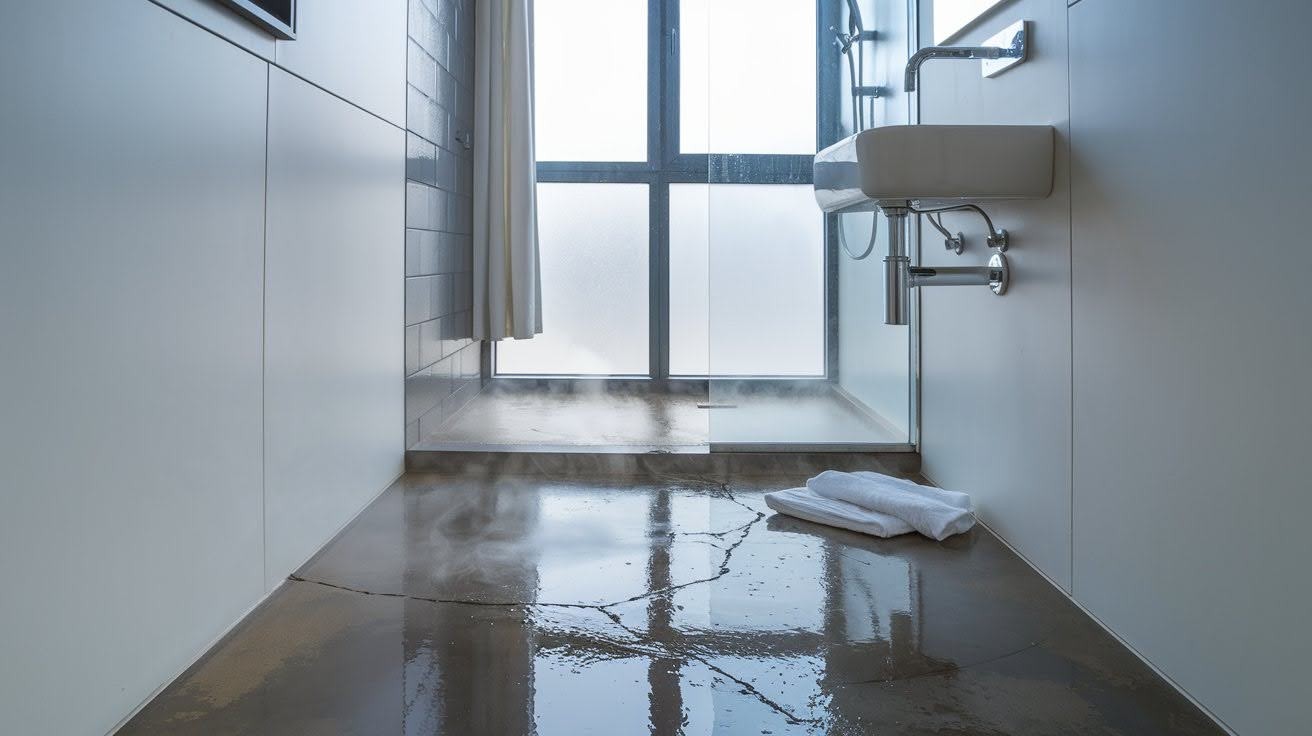
Small bathrooms face challenges that big ones don’t. Moisture hits every corner. There’s nowhere for steam to escape. Your flooring takes a beating from constant humidity.
Every square inch matters. The wrong pattern or color makes your space feel cramped. You need flooring that opens things up.
Maintenance becomes tricky. Hard-to-reach corners collect grime fast in tight spaces.
Here’s what I learned after 15 years in home renovation. Your flooring choice can make or break your small bathroom’s functionality and style.
Factors to Consider When Choosing Small Bathroom Flooring
Before we dive into specific options, let’s talk about what really matters.
Water Resistance
This isn’t negotiable. Your small bathroom gets wet. A lot. Steam from hot showers. Water splashing from the sink. That puddle your kids leave after bath time.
Look for flooring with a water resistance rating of at least IPX4. Better yet, go for completely waterproof options.
Slip Resistance
Wet floors in small spaces are dangerous. You need textured surfaces that grip your feet. Aim for a slip resistance rating of R10 or higher for bathroom areas.
Visual Impact
Here’s where most people mess up. Dark, busy patterns make small bathrooms feel smaller. Light colors and simple patterns create the illusion of space.
Large format tiles work better than small ones. They have fewer grout lines to break up the visual flow.
Budget Reality
Good bathroom flooring isn’t cheap. But skimping costs more in the long run. Plan to spend $3-15 per square foot for quality materials that last.
Best Flooring Options for a Small Bathroom
Now let’s get to the good stuff. Here are the top performers I recommend.
1. Luxury Vinyl Tile
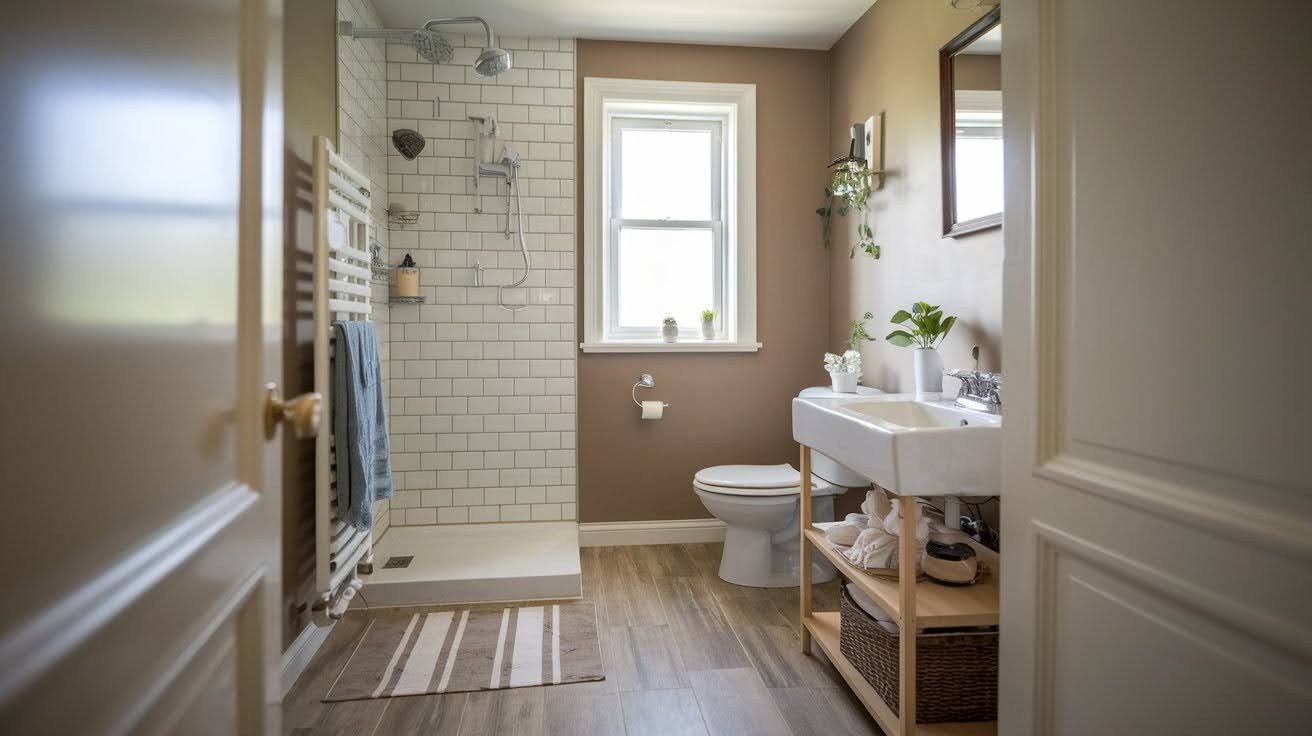
This is my top pick for most small bathrooms. It’s 100% waterproof and looks like real wood or stone. The newest versions look so realistic that guests think it’s real hardwood.
Why I recommend it:
- Completely waterproof
- Comfortable underfoot
- Easy DIY installation
- Looks like expensive materials
- Budget-friendly option
Perfect for you if you want the wood look without wood problems. Skip it if you’re going for ultra-luxury and budget isn’t a concern.
2. Porcelain and Ceramic Tiles
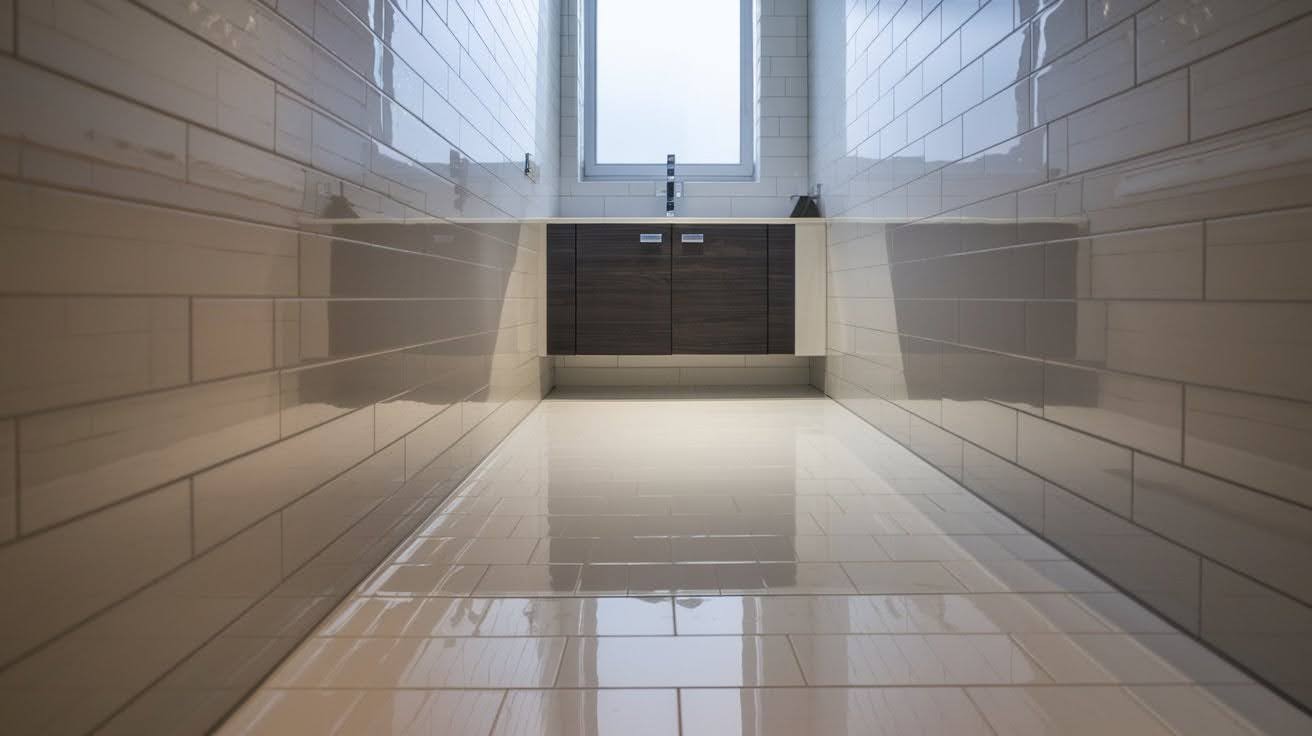
The classic choice that never goes out of style. Porcelain is denser and more water-resistant than ceramic. Both work great in small bathrooms when properly installed.
Key benefits:
- Extremely durable
- Easy to clean
- Increases home value
- Many design options
- Long-lasting investment
The downside? Grout lines collect dirt and need regular cleaning. It’s cold underfoot in winter.
3. Natural Stone
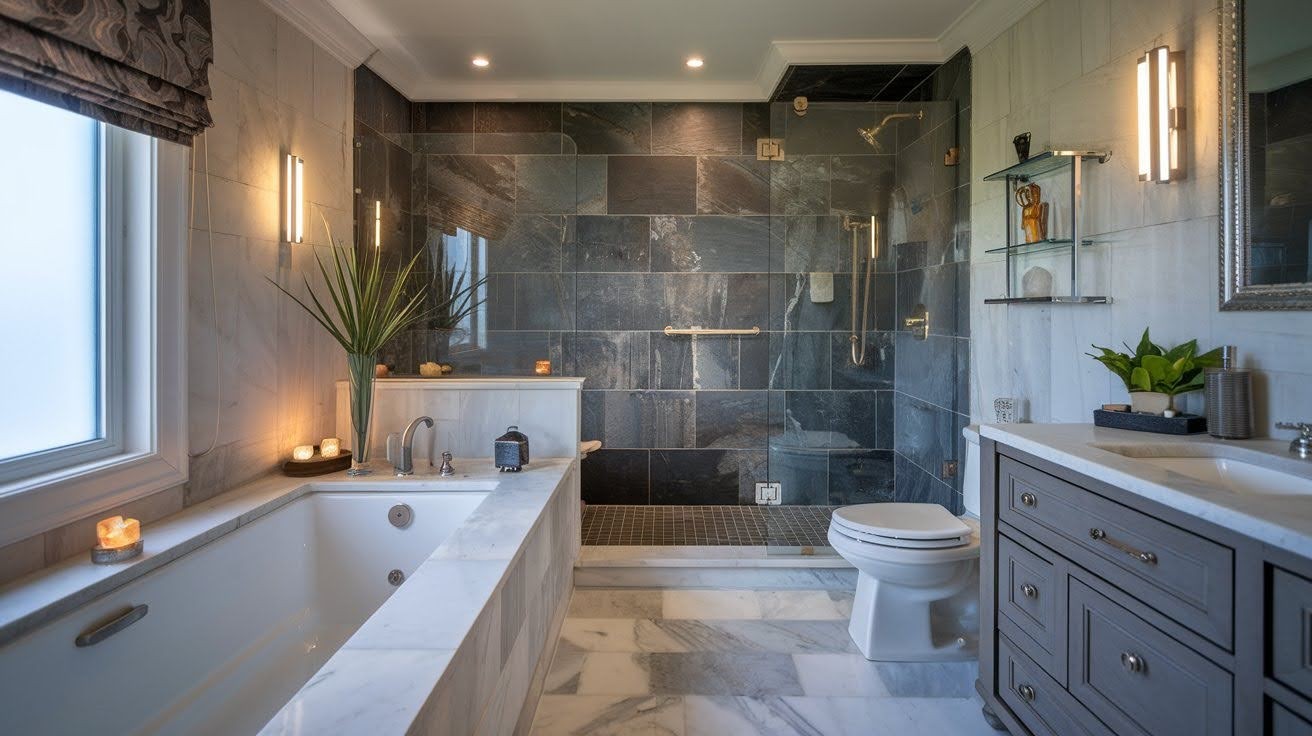
Want to create a spa-like feel? Natural stone delivers luxury like nothing else. Marble brings beauty but needs careful maintenance.
What you get:
- Premium luxury appearance
- Natural slip resistance with slate
- Spa-like atmosphere
- Increases property value
- Timeless appeal
The reality check? Natural stone is high maintenance. It stains, scratches, and needs regular sealing.
4. Waterproof Laminate Flooring
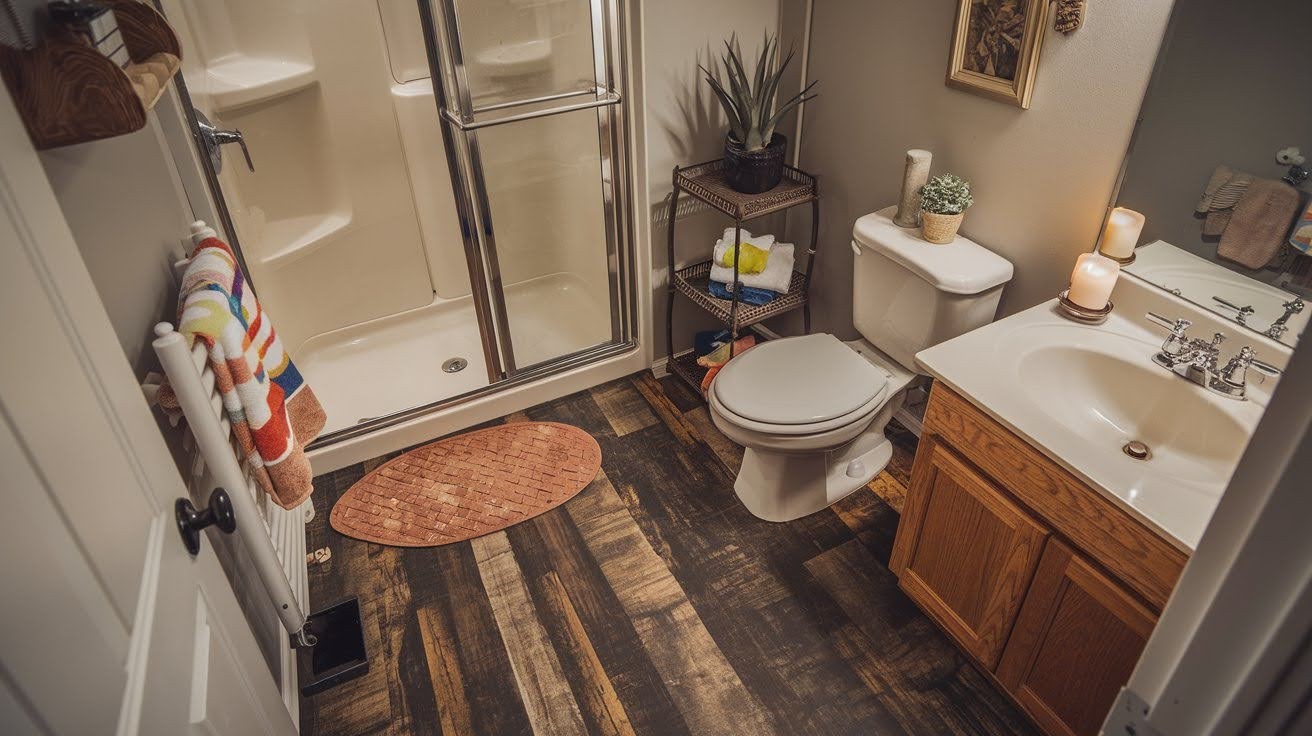
Not your grandma’s laminate. Modern waterproof laminate looks amazing and handles moisture well. It’s warmer underfoot than tile and costs less than hardwood.
Main advantages:
- Realistic wood appearance
- Warm to the touch
- Easy installation
- Pet and kid friendly
- Mid-range pricing
Watch out for edge sealing though. Poor installation leads to water damage.
5. Engineered Wood with Waterproof Finish
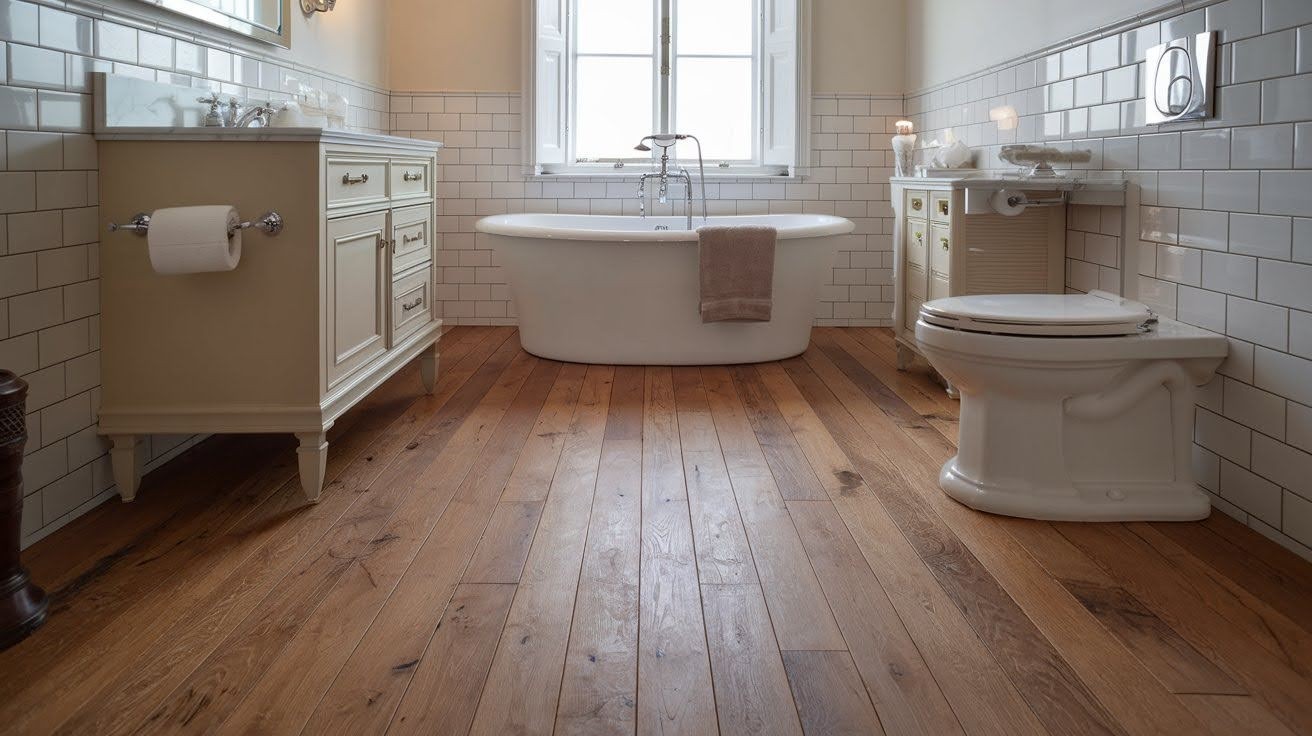
Real wood in a bathroom? Yes, it’s possible. Engineered wood with proper waterproof coating brings natural beauty to your small bathroom.
Why choose this:
- Authentic wood character
- Natural warmth
- Can be refinished
- High-end appearance
- Comfortable underfoot
But installation must be perfect. This works when humidity is well-controlled.
6. Sheet Vinyl Flooring
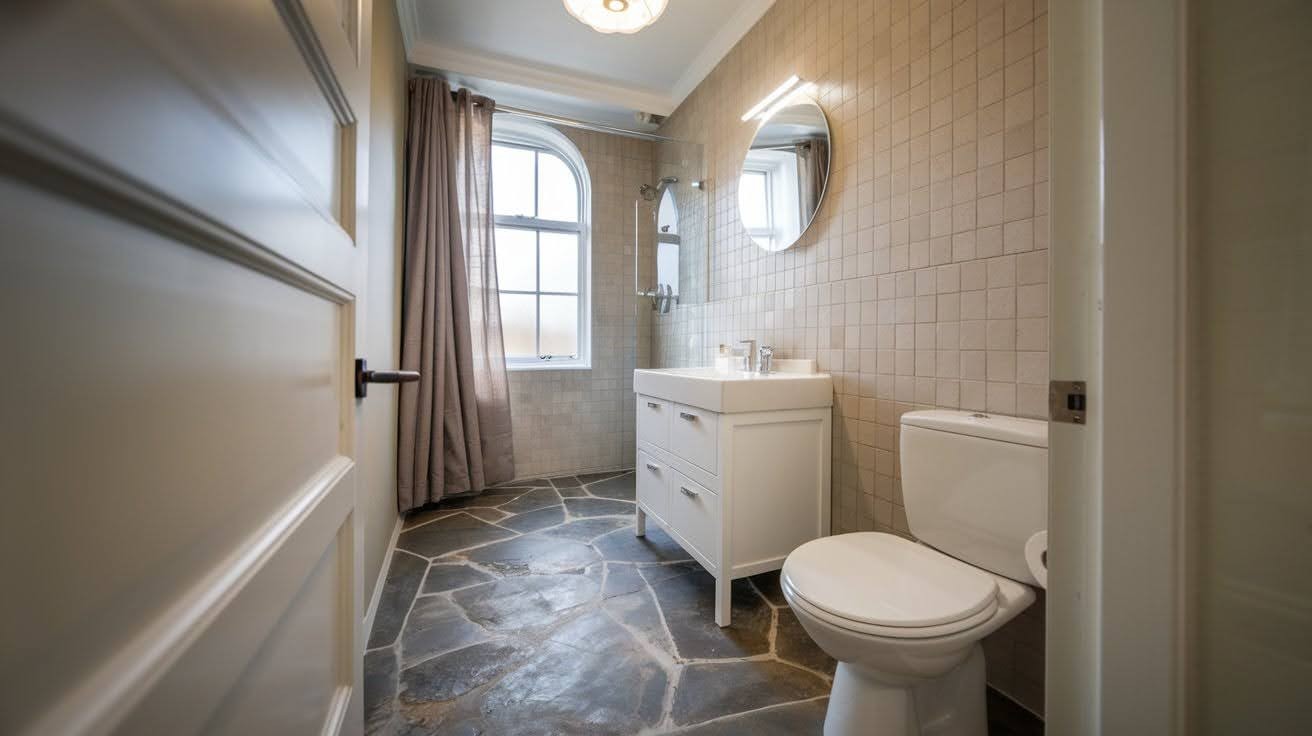
The budget champion that’s made a comeback. Today’s sheet vinyl looks nothing like the old stuff. New designs mimic expensive materials at a fraction of the cost.
Budget benefits:
- Most affordable option
- Single-sheet installation
- Soft underfoot
- Quick replacement
- Water-resistant
The downside? It can look cheap if you go too budget and tears easier than other options.
7. Cork Flooring
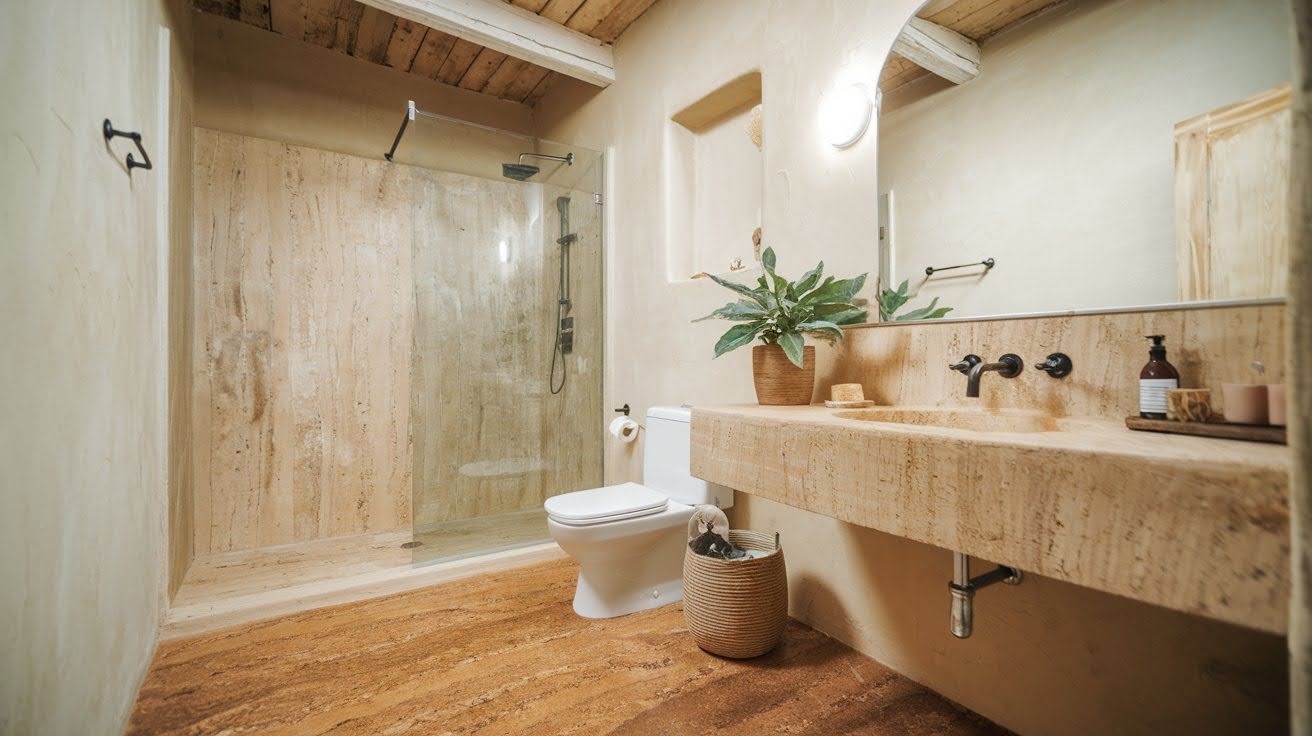
The eco-friendly surprise. Properly sealed cork flooring offers special benefits for small bathrooms. It’s naturally antimicrobial and comfortable to walk on.
Eco advantages:
- Sustainable material
- Natural slip resistance
- Sound absorption
- Antimicrobial properties
- Comfortable texture
The challenges include regular sealing requirements and limited design options.
Design Tips to Make Your Small Bathroom Look Bigger
The right flooring installation tricks can add visual space to your tiny bathroom.
Use light colors. Light grays, whites, and beiges reflect more light. They make walls appear farther away than they really are.
Go diagonal. Here’s a designer secret. Laying tile or plank flooring diagonally tricks the eye. Diagonal lines draw attention across the room instead of stopping at walls.
Minimize grout lines. Large format tiles mean fewer grout lines. Fewer lines equal less visual interruption. When you do have grout, match the color closely to your tile.
Continue patterns. Run your flooring pattern from the bathroom into adjacent hallways when possible. This visual continuation makes your bathroom feel connected to larger spaces.
Common Mistakes to Avoid
I’ve seen these mistakes cost homeowners thousands in redo work.
Ignoring subfloor prep ruins everything. Your flooring is only as good as what’s underneath. Uneven or damaged subfloors cause premature failure.
Skipping moisture barriers causes problems. Even waterproof flooring needs proper moisture protection underneath. Install vapor barriers and use appropriate adhesives.
Poor ventilation planning leads to failure. Great flooring won’t save you from moisture problems. Ensure adequate ventilation before installing any flooring.
Choosing looks over function backfires. That gorgeous white marble might photograph beautifully. But if you can’t maintain it properly, it’ll look terrible in six months.
DIY complex installations often fail. Some flooring projects are perfect for DIY. Others need professionals. Tile work, natural stone, and engineered wood typically require expert installation.
Cost Comparison
Here’s what you can expect to pay per square foot, including materials and installation:
| Flooring Type | Material Cost | Installation Cost | Total Range |
| Sheet Vinyl | $2-5 | $2-3 | $4-8 |
| Luxury Vinyl | $3-8 | $3-5 | $6-13 |
| Ceramic Tile | $2-10 | $4-8 | $6-18 |
| Porcelain Tile | $4-12 | $4-8 | $8-20 |
| Waterproof Laminate | $3-7 | $2-4 | $5-11 |
| Cork | $4-8 | $3-6 | $7-14 |
| Engineered Wood | $6-12 | $4-8 | $10-20 |
| Natural Stone | $8-25 | $6-12 | $14-37 |
Remember, these are average ranges. Premium materials and complex installations cost more.
My Recommendation
After helping countless homeowners, here’s what I recommend for most small bathrooms.
Start with luxury vinyl tile. It offers the best combination of performance, looks, and value. Choose light colors in large plank formats. Install it diagonally if your bathroom is really cramped.
If your budget allows and you want tiles, go with large format porcelain in light colors. Want natural materials? Sealed cork or properly finished engineered wood work well in the right conditions.
On a tight budget? Modern sheet vinyl looks great and performs well when properly installed.
Change Your Small Bathroom Today
I’ve given you everything I know about small bathroom flooring. The right choice makes your space feel twice as big.
My top pick remains luxury vinyl tile for most homeowners. It handles water perfectly and looks amazing. But your perfect flooring depends on your specific needs and budget.
Don’t wait months deciding. Start by measuring your bathroom and ordering samples of your top three choices. See how they look in your actual lighting.
I’ve watched too many homeowners regret rushing this decision. Take time to choose wisely. This flooring will serve you for the next 15 years.
Ready to change your cramped bathroom into a space you love? Order those samples this weekend and take the first step toward your dream bathroom.
Frequently Asked Questions
Can I install bathroom flooring myself?
Yes, luxury vinyl and sheet vinyl are perfect for DIY installation. However, tile work and natural stone require professional installation to prevent water damage and ensure proper sealing.
How long does bathroom flooring typically last?
Quality vinyl flooring lasts 10-15 years, while porcelain tile can last 20+ years with proper care. Natural stone and engineered wood fall somewhere in between at 15-20 years.
Do I need to remove existing flooring first?
It depends on what you currently have and what you’re installing. Vinyl can often go over existing vinyl, but tile usually requires removal to prevent height issues and ensure proper adhesion.
What’s the most slip-resistant option for wet areas?
Textured porcelain tile and natural slate offer the best slip resistance when wet. Look for tiles with an R11 rating or higher for maximum safety in shower areas.
Should I match my bathroom flooring to the rest of my house?
Not necessarily. Your bathroom has specific moisture requirements that matter more than matching. Choose what works best for the space, then coordinate colors and styles where possible.

